Blog
The Perils of Wearing Flip-Flops
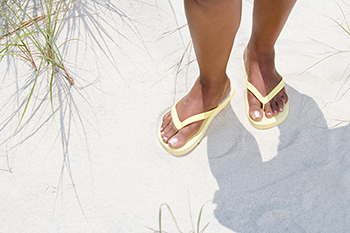
Flip-flops can have long-term negative consequences on the feet because of their lack of support. They put strain on joints and allow the foot to collapse. This affects the gait and posture and can put unnecessary pressure on the foot and rest of the body. This type of footwear contributes to our feet pronating for longer periods of time than is normal and can change the biomechanics of the feet. Foot deformities such as bunions and hammertoes, and painful conditions associated with overpronation, like arch and heel pain and overall body pain can result. Flip-flops should not be worn for prolonged lengths of time. It is okay to wear them for activities that are short-lived and not strenuous, like at the beach or around pools. If you would like to discuss wearing flip-flops or better alternatives, it is suggested that you consult with a podiatrist who can provide you with more information.
Flip-flops are not always the best choice of footwear. If you have any concerns about your feet or ankles, contact Shaun J. Limon, DPM and Lisa Griffith-Limon, DPM from Limons Foot & Ankle Care. Our doctors will assist you with all of your foot and ankle needs.
Flip-Flops and Feet
When the weather starts warming up, people enjoy wearing flip-flops. Flip-flops are comfortable, stylish, and easy to slip on and off; they're perfect for any summer beach goer. However, these shoes can cause harm to the feet.
How Can Flip-Flops Affect Me Long-Term?
- Ankle problems
- Hip problems
- Lower back problems
- Pain in the balls of the feet
- Problems with foot arches
- Changes in the way you walk
Are There Injuries Associated with Flip-Flops?
Yes. Since flip-flops are relatively weak and do not provide the same amount of support as sneakers, people who wear flip-flops regularly are more susceptible to injuries. On top of that, the open nature of the shoe makes your feet more prone to other problems, such as cuts and even infections. Common injuries and ailments include:
- Sprained ankles
- Blisters
- Infections
- Cuts and Scrapes
I like Wearing Flip-Flops. Are There Safe Alternatives?
When buying flip-flops, try to find ones that have sturdy soles and that are made of high-quality materials that will support for your feet. These flip-flops will cost more but will also last longer as a result.
If you have any questions please feel free to contact our offices located in Bradenton and Lakewood Ranch, FL . We offer the newest diagnostic and treatment technologies for all your foot and ankle needs.
Arthritis Can Cause Pain in the Feet and Ankles
Do I Need Ankle Fusion Surgery?

Ankle pain hurts and can negatively impact daily activities. There are various reasons one might have ankle pain, and having surgery performed may be an option for permanent relief. Ankle fusion surgery is described as a procedure that combines the bones of the ankle by using screws, plates, or possibly bone grafts. This is primarily done to reduce ankle arthritis, and is generally chosen as a last resort option. It may also be done to treat abnormal ankle structure, infections, or a failed ankle replacement. The benefits that may be gained by having this type of surgery performed can include improved foot stability, permanent pain relief, and it may be easier to complete daily activities. Additionally, the overall quality of life may be improved, and possible disability may be reduced. If you have ankle arthritis, it is suggested that you consult with a podiatrist who can determine if ankle fusion surgery is best for you.
Foot surgery is sometimes necessary to treat a foot ailment. To learn more, contact Shaun J. Limon, DPM and Lisa Griffith-Limon, DPM of Limons Foot & Ankle Care. Our doctors will assist you with all of your foot and ankle needs.
When Is Surgery Necessary?
Foot and ankle surgery is generally reserved for cases in which less invasive, conservative procedures have failed to alleviate the problem. Some of the cases in which surgery may be necessary include:
- Removing foot deformities like bunions and bone spurs
- Severe arthritis that has caused bone issues
- Cosmetic reconstruction
What Types of Surgery Are There?
The type of surgery you receive will depend on the nature of the problem you have. Some of the possible surgeries include:
- Bunionectomy for painful bunions
- Surgical fusion for realignment of bones
- Neuropathy decompression surgery to treat nerve damage
Benefits of Surgery
Although surgery is usually a last resort, it can provide more complete pain relief compared to non-surgical methods and may allow you to finally resume full activity.
Surgical techniques have also become increasingly sophisticated. Techniques like endoscopic surgery allow for smaller incisions and faster recovery times.
If you have any questions please feel free to contact our offices located in Bradenton and Lakewood Ranch, FL . We offer the newest diagnostic and treatment technologies for all your foot and ankle needs.
Signs of an Achilles Tendon Rupture
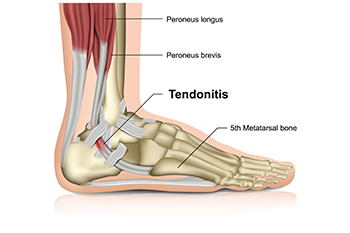
The Achilles tendon is the longest and strongest tendon in the body, and its job is to absorb a great deal of stress. This tendon connects the muscles in the calf to the heel, allowing you to be active on your feet. A ruptured Achilles tendon is either partially or completely torn, which causes a popping sound and extreme pain behind the heel. This is a common injury to athletes, usually between the ages of 30 and 40, and is more common in men than women. Symptoms of a partially torn Achilles tendon include swelling and bruising at the heel, pain while walking up stairs or hills, and difficulty bearing weight. A fully ruptured tendon, however, stops you in your tracks and requires immediate medical attention. Healing from a ruptured Achilles tendon can take as long as six months. An ankle brace or walking brace is usually prescribed, and surgery may be required to mend the torn tendon. For more information on an Achilles tendon rupture, it is suggested that you consult a podiatrist.
Achilles tendon injuries need immediate attention to avoid future complications. If you have any concerns, contact Shaun J. Limon, DPM and Lisa Griffith-Limon, DPM of Limons Foot & Ankle Care. Our doctors can provide the care you need to keep you pain-free and on your feet.
What Is the Achilles Tendon?
The Achilles tendon is a tendon that connects the lower leg muscles and calf to the heel of the foot. It is the strongest tendon in the human body and is essential for making movement possible. Because this tendon is such an integral part of the body, any injuries to it can create immense difficulties and should immediately be presented to a doctor.
What Are the Symptoms of an Achilles Tendon Injury?
There are various types of injuries that can affect the Achilles tendon. The two most common injuries are Achilles tendinitis and ruptures of the tendon.
Achilles Tendinitis Symptoms
- Inflammation
- Dull to severe pain
- Increased blood flow to the tendon
- Thickening of the tendon
Rupture Symptoms
- Extreme pain and swelling in the foot
- Total immobility
Treatment and Prevention
Achilles tendon injuries are diagnosed by a thorough physical evaluation, which can include an MRI. Treatment involves rest, physical therapy, and in some cases, surgery. However, various preventative measures can be taken to avoid these injuries, such as:
- Thorough stretching of the tendon before and after exercise
- Strengthening exercises like calf raises, squats, leg curls, leg extensions, leg raises, lunges, and leg presses
If you have any questions please feel free to contact our offices located in Bradenton and Lakewood Ranch, FL . We offer the newest diagnostic tools and technology to treat your foot and ankle needs.
Gout Pain Can Be Managed
A Foot Stretch That May Help the Plantar Fascia

People who have pain in the arch of their foot may benefit by performing specific types of stretching exercises that target that part of the foot. The plantar fascia is located on the sole of the foot and connects the heel to the toes. It can become damaged from standing or running for long periods of time, or from wearing shoes that do not fit correctly. Performing a plantar fascia stretch is done by crossing one foot over the opposite knee while sitting in a chair. It begins by grabbing the heel and pulling it with one hand and using the other hand to bring the toes in the opposite direction. This stretch is felt along the bottom of the foot and can be repeated up to four times after holding it for several seconds. The Achilles tendon connects the heels to the calf muscles, and a calf stretch can help to strengthen the heel. This can be accomplished by standing on a step and lowering one heel at a time until a gentle stretch is felt. If you would like more information about what types of foot stretches to perform for an inflamed plantar fascia, it is suggested that you confer with a podiatrist.
Why Stretching Is Important for Your Feet
Stretching the feet is a great way to prevent injuries. If you have any concerns with your feet consult with Shaun J. Limon, DPM and Lisa Griffith-Limon, DPM from Limons Foot & Ankle Care. Our doctors will assess your condition and provide you with quality foot and ankle treatment.
Stretching the Feet
Stretching the muscles in the foot is an important part in any physical activity. Feet that are tight can lead to less flexibility and make you more prone to injury. One of the most common forms of foot pain, plantar fasciitis, can be stretched out to help ease the pain. Stretching can not only ease pain from plantar fasciitis but also prevent it as well. However, it is important to see a podiatrist first to determine if stretching is right for you. Podiatrists can also recommend other ways to stretch your feet. Once you know whether stretching is right for you, here are some excellent stretches you can do.
- Using a foam roller or any cylindrical object (a water bottle or soda can will do), roll the object under your foot back and forth. You should also exert pressure on the object. Be sure to do this to both feet for a minute. Do this exercise three times each.
- Similar to the previous exercise, take a ball, such as a tennis ball, and roll it under your foot while seated and exert pressure on it.
- Grab a resistance band or towel and take a seat. If you are using a towel, fold it length wise. Next put either one between the ball of your foot and heel and pull with both hands on each side towards you. Hold this for 15 seconds and then switch feet. Do this three times for each foot.
- Finally hold your big toe while crossing one leg over the other. Pull the toe towards you and hold for 15 seconds. Once again do this three times per foot.
It is best to go easy when first stretching your foot and work your way up. If your foot starts hurting, stop exercising to ice and rest the foot. It is advised that you then see a podiatrist for help.
If you have any questions, please feel free to contact our offices located in Bradenton and Lakewood Ranch, FL . We offer the newest diagnostic and treatment technologies for all your foot care needs.
Laser Treatment for Nail Fungus
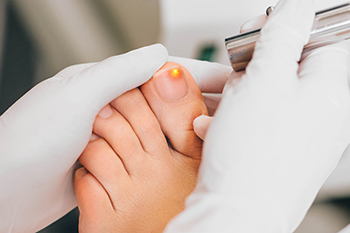
Toenail fungus, or onychomycosis, causes the nails to thicken, separate, and discolor. It is an affliction that is difficult to remove and stop from recurring. It is also contagious and can spread to other body parts and people directly exposed to it. Laser treatment uses concentrated light to help kill fungus and prevent its growth. This treatment started in the 1980s, and newer types of laser treatment have been introduced since then. Those who may benefit most from laser treatment for nail fungus include children, pregnant women, and those with underlying health conditions or problems with medication intolerances. The cost and number of sessions vary, as does insurance coverage. If you have a stubborn case of toenail fungus, it is suggested that you contact a podiatrist to discuss laser treatment as an option.
Laser treatment can be an effective way to get rid of toenail fungus. If you have any questions about laser treatment, consult with Shaun J. Limon, DPM and Lisa Griffith-Limon, DPM from Limons Foot & Ankle Care. Our doctors will assess your condition and provide you with quality treatment for fungal nails.
What Are Toenail Fungal Infections?
Onychomycosis, or fungal infection of the nail, is a relatively common and non-serious condition. Around 10 percent of U.S. citizens are afflicted with fungal nails. Common forms of fungus that infect the nail include dermatophytes, yeasts, and molds.
Symptoms of Toenail Fungal Infections Include:
- Nail thickening
- Brittleness of the nail
- Discoloration of the nail
Diagnosis for Fungal Nails
Fungal infections are diagnosed by fungal culture and microscopy. This will rule out any other conditions such as nail trauma, psoriasis, lichen planus, and onychogryphosis.
What Is Laser Treatment?
Laser treatment is a non-invasive, safe, quick, and painless procedure that uses the heat from a laser to kill fungus in the nail. Each infected nail is targeted with a laser for several minutes. The treatment is usually utilized several different times over a select period. During this time, a podiatrist will keep an eye on the infection.
If you have any questions, please feel free to contact our offices located in Bradenton and Lakewood Ranch, FL . We offer the newest diagnostic and treatment technologies for all your foot care needs.
Are Bunions Affecting Your Everyday Life?
Drinking Water and Stretching May Help to Prevent Running Injuries

Preventing injuries to the feet is an important part of the running routine. Avid runners often know the importance of tracking their shoes’ mileage, and many will have at least two pairs. The average running shoe is replaced between 300 and 500 miles and may vary with individual gaits, or running styles. It is beneficial to properly warm up and cool down before and after running. Dynamic stretching, consisting of side shuffles, walking, and lunges are done before running, and static stretches can be done after the run. These are stretches that target the glutes, calves, and hamstrings and are beneficial in keeping the body loose. Muscle cramps may be prevented by drinking plenty of water before, during, and after running. On the days when the body is resting from running, many people choose to add a full-body workout, which is an effective way of building muscular endurance. If you would like additional information about how running injuries can affect the feet and how to prevent them, it is suggested that you confer with a podiatrist.
All runners should take extra precaution when trying to avoid injury. If you have any concerns about your feet, contact Shaun J. Limon, DPM and Lisa Griffith-Limon, DPM of Limons Foot & Ankle Care. Our doctors will treat your foot and ankle needs.
How to Prevent Running Injuries
There are a lot of mistakes a runner can make prior to a workout that can induce injury. A lot of athletes tend to overstretch before running, instead of saving those workouts for a post-run routine. Deep lunges and hand-to-toe hamstring pulls should be performed after a workout instead of during a warmup. Another common mistake is jumping into an intense routine before your body is physically prepared for it. You should try to ease your way into long-distance running instead of forcing yourself to rush into it.
More Tips for Preventing Injury
- Incorporate Strength Training into Workouts - This will help improve the body’s overall athleticism
- Improve and Maintain Your Flexibility – Stretching everyday will help improve overall performance
- “Warm Up” Before Running and “Cool Down” Afterward – A warm up of 5-10 minutes helps get rid of lactic acid in the muscles and prevents delayed muscle soreness
- Cross-Training is Crucial
- Wear Proper Running Shoes
- Have a Formal Gait Analysis – Poor biomechanics can easily cause injury
If you have any questions, please feel free to contact our office located in Lakewood Ranch, FL . We offer the newest diagnostic and treatment technologies for all your foot care needs.
Working On Your Feet May Cause Injuries

Foot comfort is essential to have at all times, and especially during the work day. Many people have jobs that require mandatory standing during the majority of the day, which may lead to foot injuries. Research has shown there are two categories of foot injuries that can happen while working. Sprains, punctures, cuts, or similar injuries comprise one area and injuries that occur from slipping and tripping fall into another category. Additionally, many people develop ingrown toenails, calluses, or blisters from wearing shoes that do not fit correctly. Most injuries can cause discomfort, fatigue, and pain, and may affect the foot muscles and joints. It is beneficial for companies to provide stress mats for their employees to stand on, in addition to providing ample time for breaks. If you would like more information about how to protect your feet while working, it is suggested that you confer with a podiatrist who can provide you with the information you are seeking.
While working on the feet, it is important to take the proper care of them. For more information about working on your feet, contact Shaun J. Limon, DPM and Lisa Griffith-Limon, DPM from Limons Foot & Ankle Care. Our doctors will treat your foot and ankle needs.
Working on Your Feet
Standing on your feet for long periods of time can cause stress and pain in your feet. Your whole body may experience change in terms of posture, back pain, bunions, callouses and or plantar warts. There are ways to avoid these conditions with proper foot care, smart choices and correct posture.
Positive Changes
Negative heeled shoe – Choosing this shoe type places the heel slightly lower than the ball of the foot. These are great for overall foot health. Find shoes that fit you correctly.
Go barefoot – Our feet were not designed to be enclosed for all hours of the day. Try to periodically expose your feet to air.
Eliminate Pain
Foot Exercises – Performing simple exercises, incorporating yoga and doing stretches are beneficial. This will allow increased blood flow to the area and muscles of the foot.
Achilles tendon – Stretching the foot out flat on the floor will relax the calf muscles and tendon. These exercises can be performed almost anywhere. Make sure you add these exercises to your daily regimen.
With a little bit of this information and knowing more about foot health, you will notice changes. Foot stretches and proper footwear will help with pain and prevent further issues.
If you have any questions please feel free to contact our offices located in Bradenton and Lakewood Ranch, FL . We offer the newest diagnostic and treatment technologies for all your foot and ankle needs.
More...
Are You Suffering From Ingrown Toenails?
Dealing With Mallet Toe
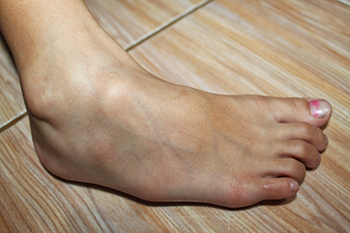
One of several common toe deformities is mallet toe. Common causes of mallet toe include the imbalance of muscle and bones, where the toe bones are too short and the muscles too weak. This imbalance forces the tip of the toe to curl under. Mallet toe commonly affects any of the three middle toes of the foot. It can also be caused by an injury, arthritis, and improperly fitting footwear. People who wear high heels with narrow toe boxes are more at risk for developing mallet toe. Other factors include genetic makeup and toe length. If the 2nd and 3rd toes are longer than the big toe, mallet toe may result. In some cases mallet toe problems can be eased simply by changing the type of shoe you wear, but in more severe cases, surgery to release the tendon and straighten the toe is an option. Recovery time for this type of surgery can take up to two months. If a mallet toe is giving you problems, it is suggested that you make an appointment with a podiatrist for an examination and a treatment plan.
Toe pain can disrupt your daily activities. If you have any concerns, contact Shaun J. Limon, DPM and Lisa Griffith-Limon, DPM of Limons Foot & Ankle Care. Our doctors can provide the care you need to keep you pain-free and on your feet.
What Causes Toe Pain?
Most severe toe pain is caused due to a sports injury, trauma from dropping something heavy on the toe, or bumping into something rigid. Other problems can develop over time for various reasons.
Toe pain can be caused by one or more ailments. The most common include:
- Trauma
- Sports injury
- Wearing shoes that are too tight
- Arthritis
- Gout
- Corns and calluses
- Hammertoe
- Bunions
- Blisters
- Ingrown toenails
- Sprains
- Fractures (broken bones)
- Dislocations
When to See a Podiatrist
- Severe pain
- Persistent pain that lasts more than a week
- Signs of infection
- Continued swelling
- Pain that prevents walking
Diagnosis
In many cases the cause of toe pain is obvious, but in others, a podiatrist may want to use more advanced methods to determine the problem. These can range from simple visual inspections and sensation tests to X-rays and MRI scans. Prior medical history, family medical history, and any recent physical traumatic events will all be taken into consideration for a proper diagnosis.
Treatment
Treatments for toe pain and injuries vary and may include shoe inserts, padding, taping, medicines, injections, and in some cases, surgery. If you believe that you have broken a toe, please see a podiatrist as soon as possible.
If you have any questions please feel free to contact our offices located in Bradenton and Lakewood Ranch, FL . We offer the newest diagnostic tools and technology to treat your foot and ankle needs.
Parts of the Foot That Are Prone to Stress Fractures
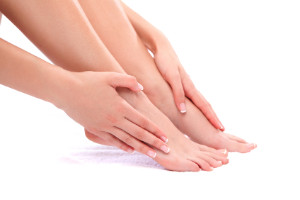
Many people will continue to walk and stand if they have a stress fracture in their foot, despite the pain it may bring. Stress fractures generally happen from overuse and are a common injury among runners. They are small or hairline cracks in the foot bones that bear the weight of the body. The repetitive force that comes from running and jumping activities may result in a stress fracture and will become worse if not promptly treated. A stress fracture can cause the bones to become weak, and a boot or cast may be worn for stability as the affected foot heals. The parts of the foot that are most affected are the heel bone, the second and third metatarsal bones in the midfoot, or one or more of the bones in the ankle joint. The symptoms that can accompany this type of injury can include pain, bruising, tenderness, and swelling. If you have endured a stress fracture in your foot, it is suggested that you consult with a podiatrist for a diagnosis and suggested treatment options.
Stress fractures occur when there is a tiny crack within a bone. To learn more, contact Shaun J. Limon, DPM and Lisa Griffith-Limon, DPM from Limons Foot & Ankle Care. Our doctors can provide the care you need to keep you pain free and on your feet.
How Are They Caused?
Stress fractures are the result of repetitive force being placed on the bone. Since the lower leg and feet often carry most of the body’s weight, stress fractures are likely to occur in these areas. If you rush into a new exercise, you are more likely to develop a stress fracture since you are starting too much, too soon. Pain resulting from stress fractures may go unnoticed at first, however it may start to worsen over time.
Risk Factors
- Gender – They are more commonly found in women compared to men.
- Foot Problems – People with unusual arches in their feet are more likely to develop stress fractures.
- Certain Sports – Dancers, gymnasts, tennis players, runners, and basketball players are more likely to develop stress fractures.
- Lack of Nutrients – A lack of vitamin D and calcium may weaken the bones and make you more prone to stress fractures
- Weak Bones – Osteoporosis can weaken the bones therefore resulting in stress fractures
Stress fractures do not always heal properly, so it is important that you seek help from a podiatrist if you suspect you may have one. Ignoring your stress fracture may cause it to worsen, and you may develop chronic pain as well as additional fractures.
If you have any questions, please feel free to contact our offices located in Bradenton and Lakewood Ranch, FL . We offer the newest diagnostic and treatment technologies for all your foot care needs.





